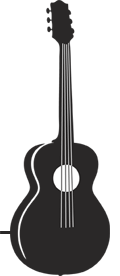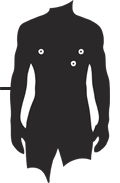The Future LOST
For LOST Magazine's annual winter theme issue (and to celebrate completing our second year of publishing), we invited just a few of the writers we admire to contribute at least one and no more than ten sentences about the "future lost." Read more...

ONE SECOND
In 1963, when I was 16, I went to my local guitar store in Minneapolis and ordered a C.F. Martin 0-16 New Yorker, the model that Paul Stookey of Peter, Paul, and Mary played: 12 frets, with a light bridge for silk-and-steel compound strings, perfect for finger-picking. Fourteen months later, what finally arrived wasn't what I ordered at all: Like the New Yorker, it also had a slotted peghead and a wide, 12-fret neck, but it bore a thick bridge and stiffer struts to accommodate heavier-gauge metal strings. I looked inside: It was a 00-21, a lovely medium-range twanger like the one used by the magnificent folk-and-blues singer Josh White, yummy for flat-picking — except I could never control a flat pick. The storekeeper, a fat old guy with bad aftershave named Rollie, warned that if I didn't take it, it'd be another year before I might get the one I'd actually wanted. So I paid him the $230 I'd saved from selling hamburgers at McDonald's.
I expect it's worth a bit more now — it was made before Brazilian rosewood became so rare that the Martin factory stopped using it: henceforth Martin guitars would never sound quite the same. But I'm not about to sell it. Last night, my wife and I sat on a sheepskin in front of our stone fireplace where, for much of the last century, maple sap was rendered to syrup. Eventually fire, accident, rot, or desiccation will claim my Martin 00-21, of which, so far, I have been sole owner. But as we harmonized to Townes Van Zandt's "If I Needed You," what emerged from its rosewood innards was as clear and sweet as the starlight outside our frosted windows, and though those unrecorded notes dissolved immediately into the night, long after my yellowing Martin is reduced to kindling, their resonance, like that of all handcrafted guitars, mandolins, violins, and cellos, will have forever charmed the universe that got to listen. — Alan Weisman

83 DAYS
In 83 days my new insurance plan will kick in, the glamorous PPO plan, and the minute it does I'm going to make an appointment to have the number of nipples in my possession reduced from three to two. I'm going to keep the "classics," the two that I've had since not long after birth. I've decided to remove the newfangled small and painful one that sprouted at age 32, just above my right classic (maybe half an inch above at around 10 o'clock, approaching my right armpit). I prefer the classics because they never throb and they don't occasionally bleed onto my undershirts. No one can talk me out of this so you can save that "what if you've been marked by God to lead in the coming war of souls" crap. — Bob Powers

FIVE MONTHS
At this moment an unseen skim of protein cells is forming at the root of your fingernail. In five months it will have grown across your nail bed to be clipped off. In those five months you will lose every cell that lines your intestines 20 times over. Your stomach lining will have been replaced 80 times. Meanwhile, half a gram of brain mass will have drifted away, never to be seen again.— Craig Childs

SIX MONTHS AND THREE YEARS
Recently, Daylight Savings Time ended. As I have at least twice a year for the past 40 years, I dialed up a familiar number on my old-fashioned land line so that I could reset my clocks accurately. The recorded voice told me, not the Pacific Standard Time, but that "Effective September 19, the time announcement service has been discontinued," and then apologized for the inconvenience. Everything about the old way of using telephones is fading away. When was the last time you used a pay phone? The other day, for no particular reason, I started making a mental note of slabs of steel in bus shelters and on the sides of buildings where pay phones used to be. If the phone company can get rid of the time announcement, they can and will get rid of pay phones. When? My guess is it will be on July 2, 2010, at the start of a long holiday weekend that marks the beginning of a roughly two month period when complaints will fall into the deaf voicemailboxes of the supervisors who are on vacation. Come September 2, a handful of people will still be prowling bus station corridors looking for a pay phone, but most of us will not notice until some time in 2011. — Bill Yenne

TEN YEARS
To build the sleek new New York Times headquarters, a 52-story steel-and-glass extravaganza that fills the block between 40th and 41st Streets along Eighth Avenue, developers knocked down a shabby three-story building that housed a variety of porn-related businesses, along with a milliner, a fabric importer, and the kind of trade schools you see advertised on the subway. Yes, this was the demise of yet one more another seedy Manhattan neighborhood. And I say that in ten years or so, there won't by any left. Gentrification will continue to sweep away the grittiness once inseparably associated with New York — think of all those noir movies of the '40s and '50s. But New York City's economy now is way too hot for grittiness. The entire planet wants to invest in New York real estate, thereby pushing prices to ever-more insane levels. Those nostalgic for the city's mean streets will just have to rent The Naked City from Netflix. — Alice Sparberg Alexiou

THIRTY YEARS
We could well lose the printed book. In perhaps 30 years. Except as a specialty item. Thereafter, we may well lose it entirely. Which does not (yet) mean the printed word, of course. But the glue-and-paper book, as opposed to the electronic book, is probably a goner. I expect, the pressure will be threefold: 1) increasing convenience/technological ease of the e-book, 2) business pragmatism with respect to print-on-demand or more targeted relationships with readers (so as to avoid massive returns, etc.), and 3) environmental pressure. The paper wasted in all those pulped overprinted books is indefensible.
So: we would solve a lot of problems by eliminating the book. Other industries have pushed back against paper for some of these very reasons. But it would break my heart, and the hearts of many, many people (I assume) for the love of holding these things, the love of reading them, the love of treasuring them and going back to them. — Rick Moody

THIRTY-THREE YEARS
Sometime in the last century the future ceased to be a time and became a place. It was a place where we would all live one day, a place of wonderment and optimism and jetpacks and labor-saving devices. Sadly, this place fell into ruin sometime around 1970 and became a slum.
Conditions are certain to get worse. The human ability for envisioning the future will eventually be eclipsed by machines that can envision it for us, and then create it. Inventor Ray Kurzweil predicts a tipping point will come in the year 2042 when machines will develop the capacity of endlessly improving themselves and the pace of technological progress will go into warp speed. We'll barely be able to hold on.
As a result, the human ability to envision the future will be unable to keep up with actual technological change. In other words, before we can even think about the future, the future will be behind us. The chief job of humans will then be to avoid slipping ever further into the past as technology hurdles onward ahead of us. — Wayne Curtis


